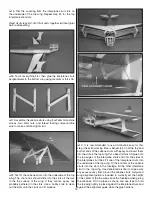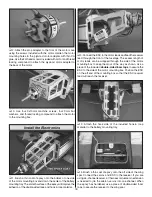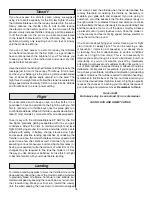
27
3D FLYING
Because of the power-to-weight ratio on 3D planes, straight
and level fl ight should be at a reduced throttle and full power
should only be used when the airplane is "loaded" during
a maneuver. Learn to manage the throttle and experiment
while in the maneuver. The power needed will depend on the
maneuver being performed. C.G. also plays a large role in
the 3D capability of models as well. Experiment, but keep in
mind that being tail heavy is not always the best way to go.
Another thing to remember is that maximum control throw is
not necessary for all 3D maneuvers. Occasionally, too much
throw can place the model too far into a stall, causing it to
become uncontrollable. Practice your maneuvers at a higher
altitude while you become accustomed to your particular
plane’s stall characteristics.
WATERFALLS
With the model pointing straight up (almost in a hover), push
full down elevator and full throttle. As the model rotates and
begins to point downwards, reduce the throttle (to keep the
model from being pulled downwards). As the model fl attens
out, add power back in to pull the model around. A lot of
models will require a little bit of rudder correction (usually
right rudder) during this maneuver. Some planes will require
aileron correction to keep the wings level.
UPRIGHT FLAT SPINS
Pull the nose up slightly and slowly decrease power. As the
model slows down to a few mph, slowly add in full left rudder
and power. Next, start adding in up elevator as needed to
keep the model fl at in the spin. Most airplanes will require
some aileron as well to keep the wings level. This is one of the
maneuvers to experiment on; try different C.G. positions and
different amounts of throw and power to see how fl at the spin
will go. It is possible to maintain altitude in the fl at spin and in
some cases it is also possible to climb during the spin.
INVERTED FLAT SPINS
This is the same as the up-right fl at spin except most planes
like to spin in the opposite direction, for example: right rudder
and down elevator.
THE WALL
Fly straight across the fi eld at a moderate speed and simply
pull full up until vertical. Adjust the power as necessary to
maintain a hover.
KNIFE EDGE TUMBLE
This is an impressive looking maneuver that really isn’t as
diffi cult as it looks. (Before learning this maneuver you must
be able to confi dently Snap and Tumble your plane and stop
the aircraft exactly, without over rotating.) Fly the model
Knife Edge from the right at a moderate airspeed, using
just enough rudder to maintain Knife Edge, not climbing or
diving. Perform one full right negative Tumble by maintaining
your rudder setting while applying full throttle, full down
elevator, and full right aileron, releasing in time to end again
fl ying Knife Edge to the right. Note that you may need to use
some positive elevator and/or left aileron to stop the Tumble
at exactly Knife Edge. This maneuver is easier to the right
because torque helps stop the Tumble and it can be done at
varied airspeeds with proper throttle and rudder modulation.
VERTICAL HOVER
Fly a straight pass across the fi eld at 75ft high and 100ft out
and pull the model vertical. Roll the model until the top of it is
facing you and slowly begin to reduce power. As the model
begins to slow down to 10mph or so, slowly add a little bit of
power back in. You will have to adjust the throttle as needed,
but make your adjustments smooth. Some right aileron may
be needed to keep the model from torque rolling. Use the
rudder and elevator to keep the nose pointing straight up. Be
patient as this maneuver will take a while to learn.


































